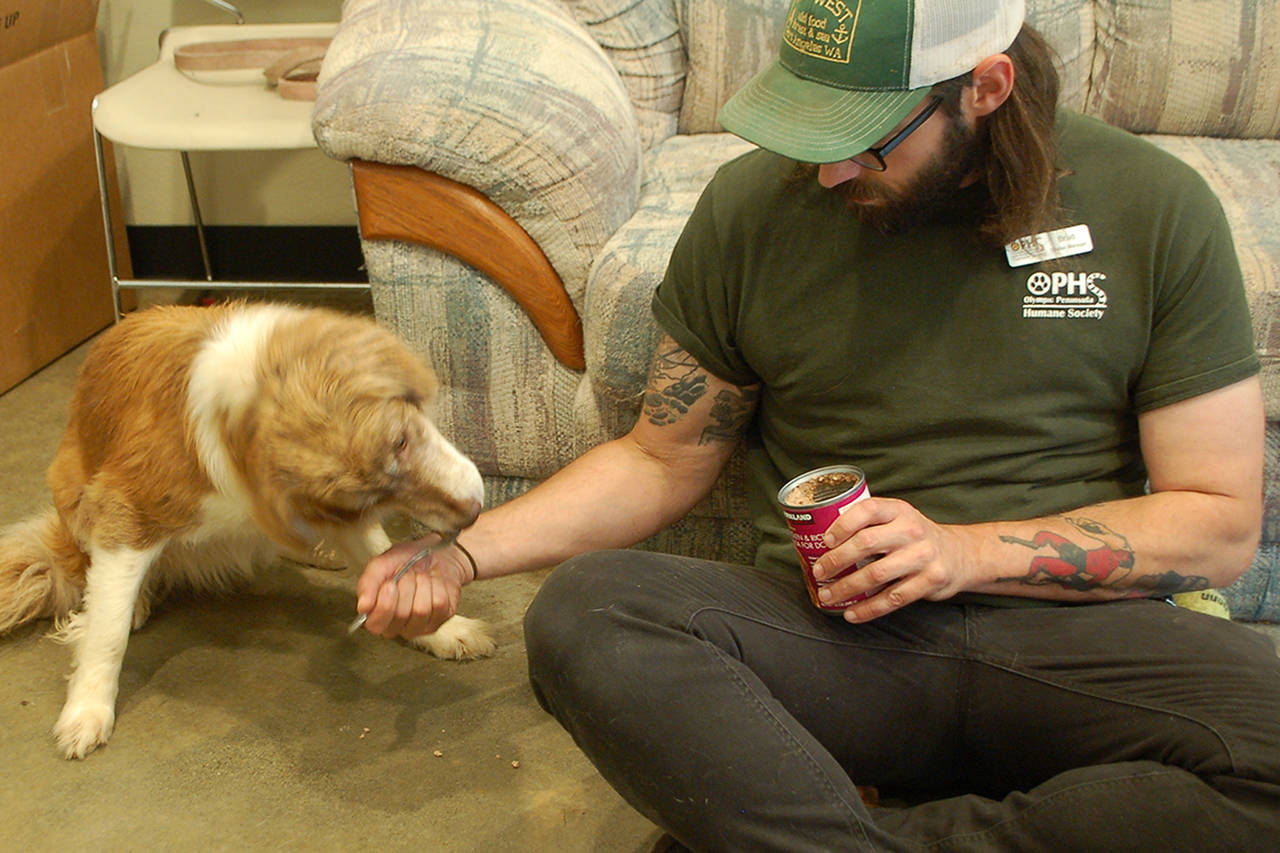In May, 29 dogs were rescued from a home in Agnew where they were in conditions that at the time members of the Welfare for Animals Guild called “the worst conditions they’ve seen” in rescue situations like that. The healing process is long for situations like this, and while some few of the dogs have been adopted already, there’s still plenty of road left to travel for the majority of the dogs.
In a visit to the Olympic Peninsula Humane Society, Luanne Hinkle, OPHS executive director, spoke warmly of working with the 11 dogs that her organization brought in, but cautioned that while two were recently adopted, the other nine will still need “a lot of work” before they’re ready for new homes — if they’re ever even going to be adoptable.
“The dogs we brought in I would consider special needs dogs,” Hinkle said. “Most of them are still very scared.
“They’re not aggressive in any way, which is good. But they’re still very scared and will tend to shy away from you.”
Adoption success
Stacy and Dale Halverson adopted the two dogs, and Stacy says that Philly and Colton are taking to their new life well.
“They’re both super, super sweet dogs,” Halverson said.
“Philly caught my eye because I was looking for a dog like her, and I knew all about her situation going into meeting her the first time,” Halverson continued, adding that the adoption process was much longer than a more traditional dog adoption, requiring several visitations before she could finalize things.
Colton was in the visitation room the first time the Halversons met Philly, and after learning that the dogs had run into their kennel together on their own upon arriving at OPHS and had stayed together since, the couple knew they had to adopt them both.
Philly and Colton came home on July 5, Halverson said, and she has been pleasantly surprised by how they’ve adapted to their new home since then.
“There’s definitely some things we’re still working on,” she said. “They get into the garbage when we’re gone, there’s potty training and even toy-related things they just didn’t know about before.”
The Halversons’ cat also doesn’t appreciate being barked at and occasionally chased around the house, Stacy said laughing.
But everthing else is going very well.
“They can be a little leery of things, but they’re so smart and learning very quickly,” Halverson said, adding that both dogs are already turning into “real people pleasers.” Even leash training has gone smoothly, especially considering that OPHS had only just started working on that with Philly and Colton shortly before the adoption.
“Colton had issues with having a collar around his neck,” Halverson said, “but we got them harnesses and that’s worked really well. They’ve responded wonderfully to going on walks.”
Socialization with other people is still a work in progress, but Stacy is pleased with what she’s seen so far. She said that both dogs did well in managing themselves at a recent gathering of friends at their house, withdrawing to safe spaces like their kennel when they got overwhelmed without making a scene out of it, but coming out again when they were ready to without prompting.
“They’re absolutely wonderful dogs,” Halverson finished.
Work still to do
While Philly and Colton are doing well, their compatriots are still a long ways away from being able to be adopted themselves.
According to Hinkle, OPHS staff spend as much time as they can just being around the dogs who are still there, often just sitting in their kennels just being with them and occasionally giving them food so they start to build positive associations with people.
“These dogs were never socialised and hardly even saw a human before we rescued them,” Hinkle said. “They’ve got a lot of catching up to do.”
According to Hinkle, OPHS is looking for a behavioral specialist to come work with the dogs. As much as their staff tries to do for them, there’s only so much time that can go around to give the dogs the care and attention that they need.
OPHS has raised several thousand dollars specifically for helping these dogs already, and are still taking further donations. Hinkle says that care for the dogs costs around $1,000 per dog per year given all the work that needs to be done with them.
“Medically, these dogs are in great shape now,” Hinkle said. “But there’s so much more left to do beyond that.”
In a visit with one of the dogs still at OPHS, a younger female named Leidi, it was hard to miss the obvious concern the dog had about the situation. When she was brought into one of OPHS’ visitation rooms, Leidi immediately ran under a metal chair and hid, only coming out when offered some wet food by Brad Evans, the shelter manager at OPHS.
Leidi did eventually start moving around a little more after eating, but even then she was moving very low with her tail flat down against her hindquarters, a sign of a scared dog. That was further reinforced by her visibly shaking almost every time she stopped moving.
Eventually Leidi was willing to accept some gentle petting, but even then she was constantly fidgeting and turning around to smell the person petting her again, as though to make sure she still knew who it was. The instant anyone stood up or moved, Leidi was back under the chair.
“And she’s probably the dog doing the best socially of those we still have,” Hinkle said almost mournfully.
For more about the Olympic Peninsula Humane Society, see www.ophumane society.org or call 360-457-8206.
For more about Welfare for Animals Guild, see www.wagsequimwa.com.



